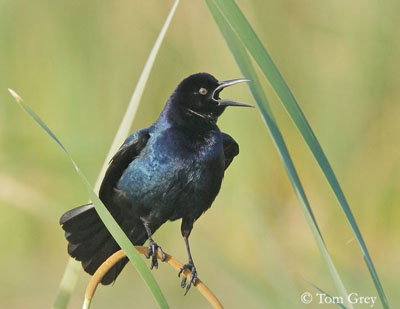
Boat-tailed Grackle
Quiscalus major
Passeriforme Order – Icteridae Family
BIOMETRICS:
Lenght : 26 à 37 cm
Wingspan : 39 à 50 cm
Weight : 93 à 239 g
LONGEVITY: Up to 11 years
DESCRIPTION:
Boat-tailed Grackle male has iridescent plumage, with wings and long keel-shaped tail more greenish. Eyes are yellow or brown.
Blackish bill is slightly down curved. Legs and feet are black.

Female has tawny brown upperparts, with darker wings and tail. Breast is pale brown. Eyes are yellow to dark brown. She is smaller than male, almost one half-size.
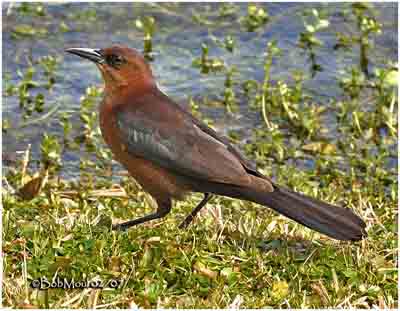
Juvenile male has black plumage without iridescences and brown eyes.
Juvenile female shows vague spots and streaks on breast.
Juveniles resemble respective adults in fall.
Common Grackle and Great-tailed Grackle are similar species.
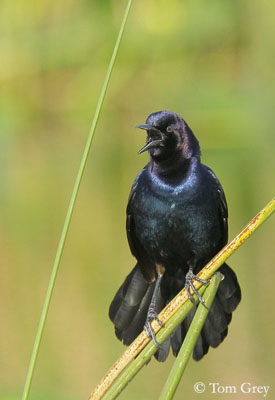
VOICE: SOUNDS BY XENO-CANTO
Boat-tailed Grackle’s calls include a quiet “chuck” and variety of rough squeaks, rattles, chatters, whistles and raspy clicks.
Song is a series of loud “jeeb-jeeb-jeeb” repeated notes.
HABITAT:
Boat-tailed Grackle lives in coastal saltwater marshes, but in Florida, it also inhabits around ponds and lakes. We can find it in both cultivated and urban areas.
RANGE:
Boat-tailed Grackle breeds along Atlantic Coast from New York to Florida, and west along Gulf Coast to Texas.
It winters in most of its range, but northern birds move southwards, depending of the weather.
BEHAVIOUR:
Boat-tailed Grackle is gregarious all year round and active during the day. They often gather in large flocks to feed and roost among tall marsh grasses. They are very noisy until dusk.
It forages on the ground, in shallow water or in shrubs. It searches for food among salt marshes, muddy shores or into rice plantations. It may pick insects off the cattle backs.

In earlier February, Boat-tailed Grackle has very beautiful breeding plumage, with tail deeply incurved towards centre. It performs displays to expose its iridescent colours, alighting on top of branches, drooping wings and tail, swelling its breast, and glittering in the sun, while it calls its loud song.
It looks at other males as they pass, chasing them with courage, and returns to its perch, singing its song again.
Boat-tailed Grackle male is polygamous, and competes with other males. Dominant male gets a lot of copulations, but it only gets about 25% of the young in the colony. Females mate with males strangers from the colony.
It is a courageous bird, chasing Hawks and Turkey Buzzards. Male defends nesting territory where several females build nests. Each female defends a small territory around her nest.

FLIGHT:
Boat-tailed Grackle performs a direct flight with rapid wing beats. It has strong flight with long tail extended behind.
REPRODUCTION:
Boat-tailed Grackle’s nest is a bulky cup of grass, built by female often over water. Nest is located in cattails, bushes, marsh grass or trees near water, from 6 inches to 80 feet above the ground. It is made with dry grasses, twigs, moss and feathers. Interior is made with fine grass, and lined with thready roots.
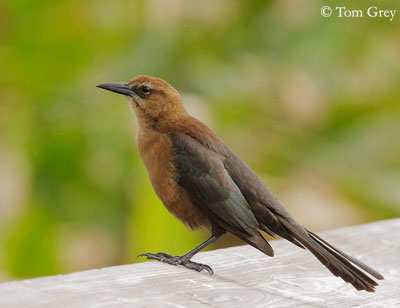
Female lays 3 to 5 pale blue eggs spotted with dark. Incubation lasts about 13 to 14 days, by female, while male flies off with others.
Chicks hatch altricial, covered with sparse brown down.
Female feeds the young during two or three weeks. They fledge at about 20 to 23 days. If young fall into the water, they can swim on short distances, using their wings as paddles.
Young female may reach its sexual maturity at one year, and young male later.
This species produces two or three clutches per year.
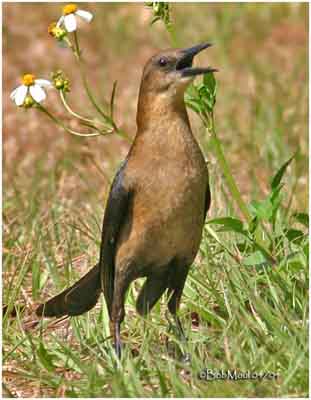
DIET:
Boat-tailed Grackle feeds mainly on small crabs, large insects of all kinds, earth worms, seeds and grain. It also eats shrimps and aquatic animals, and rice in autumn. It may feed on lizards, frogs and turtles, and food scavenged from humans.
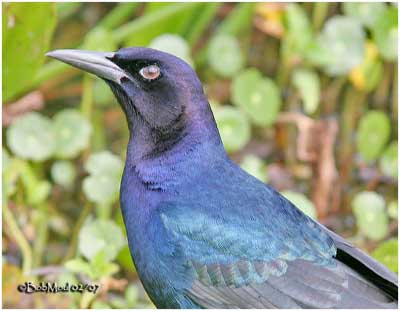
PROTECTION / THREATS / STATUS:
In Florida, eggs and nestlings are threatened by alligators, snakes and rats.
Boat-tailed Grackles cause damages in rice fields, while they feed in large flocks.
However, this species is very common, and numbers are stable.
Fr: Quiscale des marais
All : Bootschwanzgrackel
Esp : Zanate Pico de Bote
Ital : Gracchio maggiore americano
Nd : Bootstaarttropiaal
Sd : Större batstjärt
Photographs by Bob Moul
His website : Nature Photography
Photographs by Tom Grey
His website : Tom Grey's Bird Pictures
Text by Nicole Bouglouan
Sources:
NEW WORLD BLACKBIRDS – THE ICTERIDS by Alvaro Jaramillo and Peter Burke – Helm - ISBN : 0713643331
FIELD GUIDE TO THE BIRDS OF NORTH AMERICA by National Geographic Society - National Geographic Society - ISBN: 0792274512
All About Birds (Cornell Lab of Ornithology)
What Bird-The ultimate Bird Guide (Mitchell Waite)
Wikipedia (Wikipedia, The Free Encyclopedia)